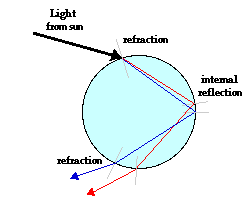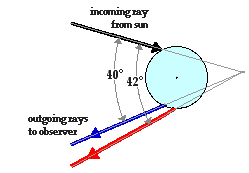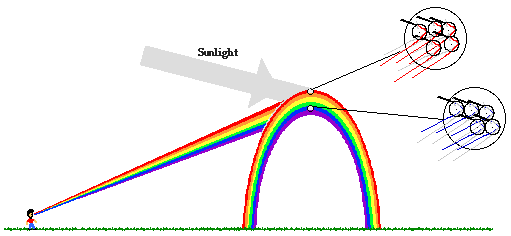1. Rajnikanth killed the Dead Sea.
2. When Rajnikanth does push-ups, he isn't lifting himself up. He is pushing the earth down.
3. There is no such thing as evolution, it's just a list of creatures that Rajnikanth allowed to live.
4. Rajnikanth gave Mona Lisa that smile.5. Rajnikanth can divide by zero.
6. Rajnikanth can judge a book by its cover.
7. Rajnikanth can drown a fish.
8. Rajnikanth can delete the Recycle Bin.
9. Rajnikanth once got into a fight with a VCR player. Now it plays DVDs.
10. Rajnikanth can slam a revolving door.
11. Rajnikanth once kicked a horse in the chin. Its descendants are today called giraffes.
12. Rajnikanth once ordered a plate of idli in McDonald's, and got it.
13. Rajnikanth can win at Solitaire with only 18 cards.
14. The Bermuda Triangle used to be the Bermuda Square, until Rajnikanth kicked one of the corners off.
15. Rajnikanth can build a snowman out of rain.
16. Rajnikanth can strangle you with a cordless phone.
17. Rajnikanth can make onions cry.
18. Rajnikanth destroyed the periodic table, because he only recognises the element of surprise.
19. Rajnikanth has counted to infinity, twice.
20. Rajinikanth can watch the show 60 minutes in 20 minutes.
21. Rajnikanth will attain separate statehood in 2013.
22. Rajnikanth did, in fact, build Rome in a day.
23. Rajnikanth once got into a knife-fight. The knife lost.
24. Rajnikanth can play the violin with a piano.
25. Rajnikanth never wet his bed as a child. The bed wet itself in fear.
26. The only man who ever outsmarted Rajnikanth was Stephen Hawking, and he got what he deserved.
27. Rajnikanth can talk about Fight Club.
28. Rajnikanth doesn't breathe. Air hides in his lungs for protection.
29. There are no weapons of mass destruction in Iraq. Rajnikanth lives in Chennai.
30. Rajnikanth kills Harry Potter in the eighth book.
31. Rajnikanth does not own a stove, oven, or microwave, because revenge is a dish best served cold.
32. Rajnikanth has already been to Mars, that's why there are no signs of life there.
33. Rajnikanth doesn't move at the speed of light. Light moves at the speed of Rajnikanth.
34. Rajnikanth knows Victoria's secret.
35. Water boils faster when Rajnikanth stares at it.
36. Rajinikanth is the only man to ever defeat a brick wall in a game of tennis.
37. Rajnikanth kills two stones with one bird.
38. google won't find rajnikanth because you don't find him, rajni finds you
39. Rajnikanth gave the Joker his scars.
40. Rajnikanth leaves messages before the beep.
41. Rajnikanth once warned a young girl to be good "or else". The result? Mother Teresa.
42. Rajnikanth electrocuted Iron Man.
43. Rajnikanth killed SpiderMan using Baygon anti-bug spray.
44. Rajnikanth can make PCs better than the Mac.
45. Rajnikanth puts the laughter in 'manslaughter'.
46. Rajnikanth goes to court and sentences the judge.
47. Rajnikanth can handle the truth.
48. Rajnikanth can speak Braille.
49. Rajnikanth can dodge Chuck Norris' roundhouse kicks.
50. Rajnikanth calls Voldemort by his name.
51. Who do you think taught Voldemort Parseltongue? Rajnikanth did.
52. Rajnikanth can teach an old dog new tricks
53. Chuck Norris once met Rajnikanth. The result he was reduced to a joke on the Internet.
54. Rajnikanth got small pox when he was a kid. As a result, small pox is now eradicated.
55. Rajnikanth's calendar goes straight from March 31st to April 2nd, no one fools Rajnikanth.
56. Rajnikanth grinds his coffee with his teeth and boils the water with his own rage.
57. The last time Rajnikanth killed someone, he slapped himself to do it. The other guy just disintegrated. Resonance.
58. Rajnikanth once had a heart attack. His heart lost.
59. Rajnikanth is so fast, he can run around the world and punch himself in the back of the head.
60. Rajnikanth can run at speed of light around a tree and screw himself.
61. Rajnikanth can lick his elbows.
62. Rajnikanth once ate an entire bottle of sleeping pills. They made him blink.
63. Rajnikanth does not get frostbite. Rajnikanth bites frost.
64. Rajnikanth doesn't wear a watch. He decides what time it is.
65. Rajnikanth got his driver's licence at the age of 16 seconds.
66. When you say "no one is perfect", Rajnikanth takes this as a personal insult.
67. In an average living room there are 1,242 objects Rajnikanth could use to kill you, including the room itself.
68. Words like awesomeness, brilliance, legendary etc. were added to
the dictionary in the year 1949. That was the year Rajnikanth was born.
69. The statement "nobody can cheat death", is a personal insult to Rajnikanth. Rajni cheats and fools death everyday.
70. When Rajnikanth is asked to kill some one he doesn't know, he shoots the bullet and directs it the day he finds out.
71. Rajnikanth can give pain to painkillers and headache to Anacin.
72. Rajnikanth knows what women really want.
73. Time and tide wait for Rajnikanth.
74. Rajnikanth sneezed only once in his entire life, that's when the tsunami occurred in the Indian ocean.
75. As a child when Rajnikanth had dyslexia, he simply re-scripted the alphabet.
76. Rajnikanth collects Honey from his private Moon HoneyMoon.
77. Rajnikanth can answer a missed call.
78. Rajnikanth doesn't need a visa to travel abroad, he just jumps from
the tallest building in Chennai and holds himself in the air while the
earth rotates.
79. Rajnikanth's brain works faster than Chacha Chaudhury's.
80. Rajnikanth doesn't shower. He only takes blood baths.
81. To be or not to be? That is the question. The answer? Rajnikanth.
82. The quickest way to a man's heart is with Rajnikanth's fist.
83. Where there is a will, there is a way. Where there is Rajnikanth, there is no other way.
84. Rajnikanth's every step creates a mini whirlwind. Hurricane Katrina was the result of a morning jog.
85. Rajnikanth doesn't bowl strikes, he just knocks down one pin and the other nine faint out of fear.
86. Archaeologists unearthed an old English dictionary dating back to
the year 1236. It defined "victim" as "one who has encountered
Rajnikanth".
87. There is no such thing as global warming. Rajnikanth was feeling cold, so brought the sun closer to heat the earth up.
88. Once a cobra bit Rajnikanth' leg. After five days of excruciating pain, the cobra died.
89. Rajnikanth is a champion in the game 'hide n' seek', as no one can hide from Rajnikanth.
90. Rajnikanth proves Newton wrong all the time. Every time he performs
an action, he simply eliminates anything and everything that can
provide the reaction.
91. Rajnikanth is a weapon created by God to use on doomsday to end the world.
92. Aliens do indeed exist. They just know better than to visit a planet that Rajnikanth is on.
93. We live in an expanding universe. All of it is trying to get away from Rajnikanth.
94. If at first you don't succeed, you're not Rajnikanth.
95. Rajnikanth's first job was as a bus conductor. There were no survivors.
96. Rajnikanth does not style his hair.It lays perfectly in place out of sheer terror.
97. When Rajnikanth plays Monopoly, it affects the actual world economy.
98. Rajnikanth's house has no doors, only walls that he walks through.
99. Gmail's new ID: gmail@rajnikanth.com
100. 'Robot is released. Rajnikanth gives Times of India 3 stars.
 There
are countless paths by which light rays from the sun can pass through a
drop. Each path is characterized by this bending towards and away from
the normal. One path of great significance in the discussion of rainbows
is the path in which light refracts into the droplet, internally
reflects, and then refracts out of the droplet. The diagram at the right
depicts such a path. A light ray from the sun enters the droplet with a
slight downward trajectory. Upon refracting twice and reflecting once,
the light ray is dispersed and bent downward towards an observer on
earth's surface. Other entry locations into the droplet may result in
similar paths or even in light continuing through the droplet and out
the opposite side without significant internal reflection. But for the
entry location shown in the diagram at the right, there is an optimal
concentration of light exiting the airborne droplet at an angle towards
the ground. As in the case of the refraction of light through prisms
with nonparallel sides, the refraction of light at two boundaries of
the droplet results in the dispersion of light into a spectrum of
colors. The shorter wavelength blue and violet light refract a slightly
greater amount than the longer wavelength red light. Since the
boundaries are not parallel to each other, the double refraction results
in a distinct separation of the sunlight into its component colors.
There
are countless paths by which light rays from the sun can pass through a
drop. Each path is characterized by this bending towards and away from
the normal. One path of great significance in the discussion of rainbows
is the path in which light refracts into the droplet, internally
reflects, and then refracts out of the droplet. The diagram at the right
depicts such a path. A light ray from the sun enters the droplet with a
slight downward trajectory. Upon refracting twice and reflecting once,
the light ray is dispersed and bent downward towards an observer on
earth's surface. Other entry locations into the droplet may result in
similar paths or even in light continuing through the droplet and out
the opposite side without significant internal reflection. But for the
entry location shown in the diagram at the right, there is an optimal
concentration of light exiting the airborne droplet at an angle towards
the ground. As in the case of the refraction of light through prisms
with nonparallel sides, the refraction of light at two boundaries of
the droplet results in the dispersion of light into a spectrum of
colors. The shorter wavelength blue and violet light refract a slightly
greater amount than the longer wavelength red light. Since the
boundaries are not parallel to each other, the double refraction results
in a distinct separation of the sunlight into its component colors. The angle of deviation
between the incoming light rays from the sun and the refracted rays
directed to the observer's eyes is approximately 42 degrees for the red
light. Because of the tendency of shorter wavelength blue light to
refract more than red light, its angle of deviation from the original
sun rays is approximately 40 degrees. As shown in the diagram, the red
light refracts out of the droplet at a steeper angle toward an observer
on the ground. There are a multitude of paths by which the original ray
can pass through a droplet and subsequently angle towards the ground.
Some of the paths are dependent upon which part of the droplet the
incident rays contact. Other paths are dependent upon the location of
the sun in the sky and the subsequent trajectory of the incoming rays
towards the droplet. Yet the greatest concentration of outgoing rays is
found at these 40-42 degree angles of deviation. At these angles, the
dispersed light is bright enough to result in a rainbow display in the
sky. Now that we understand the path of light through an individual
droplet, we can approach the topic of how the rainbow forms.
The angle of deviation
between the incoming light rays from the sun and the refracted rays
directed to the observer's eyes is approximately 42 degrees for the red
light. Because of the tendency of shorter wavelength blue light to
refract more than red light, its angle of deviation from the original
sun rays is approximately 40 degrees. As shown in the diagram, the red
light refracts out of the droplet at a steeper angle toward an observer
on the ground. There are a multitude of paths by which the original ray
can pass through a droplet and subsequently angle towards the ground.
Some of the paths are dependent upon which part of the droplet the
incident rays contact. Other paths are dependent upon the location of
the sun in the sky and the subsequent trajectory of the incoming rays
towards the droplet. Yet the greatest concentration of outgoing rays is
found at these 40-42 degree angles of deviation. At these angles, the
dispersed light is bright enough to result in a rainbow display in the
sky. Now that we understand the path of light through an individual
droplet, we can approach the topic of how the rainbow forms.
